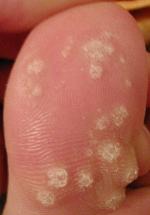Verrucae
| Warts | |
|---|---|
| Synonyms | Verruca, papillomas |
 |
|
| A large number of warts on the big toe | |
| Specialty | Dermatology |
| Symptoms | Painless, small, rough skin growth |
| Duration | Months to years |
| Causes | Human papillomavirus |
| Risk factors | Public showers, eczema |
| Similar conditions | Callus, seborrheic keratosis, squamous cell carcinoma |
| Treatment | Salicylic acid, cryotherapy |
| Frequency | Very common |
| Classification | |
|---|---|
| External resources |
Warts are typically small, rough, and hard growths that are similar in color to the rest of the skin. They typically do not result in symptoms except when on the bottom of the feet where they may be painful. While they usually occur on the hands and feet they can also affect other locations. One or many warts may appear. They are not cancerous.
Warts are caused by infection with a type of human papillomavirus (HPV). Factors that increase the risk include use of public showers, working with meat, eczema, and a low immune system. The virus is believed to enter the body through skin that has been damaged slightly. A number of types exist including: common warts, plantar warts, filiform warts, and genital warts. Genital warts are often sexually transmitted.
Without treatment, most types of warts resolve in months to years. A number of treatments may speed resolution including salicylic acid applied to the skin and cryotherapy. In those who are otherwise healthy they do not typically result in significant problems. Treatment of genital warts differ from that of other types.
Warts are very common, with most people being infected at some point in time. The estimated current rate of non-genital warts among the general population is 1–13%. They are more common among young people. Estimated rates of genital warts in sexually active women is 12%. Warts have been described at least as far back as 400 BC by Hippocrates.
A range of types of wart have been identified, varying in shape and site affected, as well as the type of human papillomavirus involved. These include:
Warts are caused by the human papilloma virus (HPV). There are about 130 known types of human papilloma viruses. HPV infects the squamous epithelium, usually of the skin or genitals, but each HPV type is typically only able to infect a few specific areas on the body. Many HPV types can produce a benign growth, often called a "wart" or "papilloma", in the area they infect. Many of the more common HPV and wart types are listed below.
...
Wikipedia
